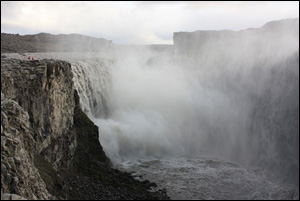Though it lies just a few hundred miles beyond Scotland’s northern coast, Iceland has an altogether otherworldly feel. Arriving on the frozen, barren sands of this sub-Arctic Nordic nation you can imagine that you are a million miles away from Britain’s sedate pastures.
Iceland is a land of immense canyons, volcanic eruptions, violent geysers, melting glaciers and thunderous waterfalls, and here is a look at some of the best of these volcanic attractions:
Dettifoss
Iceland is full of impressive waterfalls of all shapes and sizes, but perhaps the most impressive of all is Dettifoss, an incredible cataract some 328 feet wide. Dettifoss has a flow rate of 6,816 cubic feet per second, making it by far the most powerful waterfall in Europe. Nothing can prepare you for the sheer sight and deafening noise of seeing this incredible natural spectre in person. Icy cold water plunges over the ravine with a crashing roar, carrying car-sized boulders with it.
Dettifoss sits within the impressive Vatnajökull National Park, where a host of activities are on offer, including ice-climbing, hiking and white water rafting, so any visit to this incredible natural wonder can easily be combined with adventure holidays.
Eyjafjallajökull
It’s a bit of a mouthful and I am convinced that even native Icelanders don’t know how to pronounce the name of this fierce volcano, but Eyjafjallajökull provides some of the most dramatic natural scenes in the world. The volcano, which shot to global infamy in 2010 after an eruption spread clouds of dark ash across Europe, has settled down a bit now and started to attract the tourists.
Though visitors cannot get particularly close to the volcano, which is still producing levels of white hot magma, you can approach the surrounding glacier that tumbles down the mountain side like molten glass. Not nearly as white as it was a couple of years ago, the glacier has been stained by the ash and lava flows produced in the eruption, testament to the earth’s awesome and unmatchable power.
Great Geysir
Active for at least 10,000 years according to geologists, this ancient geyser is the largest and most famous of Iceland’s incredible spouting specimens. Even during dormant periods plumes of thick, white steam can be seen for miles around as they rise hundreds of feet up into the air. Yet, it is during these bursts of steaming hot water that the Great Geysir is at its most impressive, with vertical gushes of hot water reaching up to 400 feet in height during periods of tectonic activity.
Make sure you don’t stand too close to the spouting geyser, however, unless you want to be drenched in jets of boiling water. Just a short ride from the geyser lies Þingvellir, the site of Iceland’s first ever national parliament over a thousand years ago, surrounded by rocky escarpments, fast rivers and lush meadows.
The Blue Lagoon
Iceland’s most user-friendly volcanic attraction has to be the Blue Lagoon which features warm hot springs and is located just 40 minutes from the capital of Reykjavik. The mineral rich lagoon has a blue tint to it, hence the name, and is known to help people who suffer from skin diseases and ailments. In fact, a renowned research facility has opened at the site to study the water’s natural properties.
The temperature here is never too hot, and the waters not particularly deep, making it a great destination for those on family holidays abroad in Iceland. The best time to visit is probably during the early morning or on a winter’s afternoon, just as the sun begins to set.
About the author: John is a travel writer who has written on subjects as diverse as adventure holidays in Britain to finding the best surfing spots in Australia.
Credits: Photo courtesy of Arian Zwegers.
